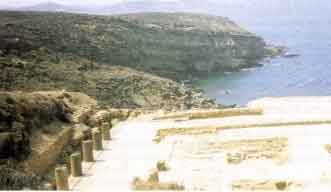.

Lemnos (mod. Limnos), an island in the northern part of the Aegean Sea. The island, part of the Greek prefecture of Lesbos, is of considerable size: the area has been estimated at 150 sq.m. A great part is mountainous, but some very fertile valleys exist. The hillsides afford pasture for sheep. A few mulberry and fruit trees grow, but no olives. The chief towns are Myrina on the western coast, and Mudros on the southern coast. Myrina (aka Kastro) possesses an excellent harbour, and is the seat of all the trade carried on with the island.
Mythic Lemnos
In ancient times the island was sacred to Hephaestus, who as the legend tells fell on Lemnos when his father Zeus hurled him headlong out of Olympus. There he was cared for by the Sinties, according to Iliad I:590ff or by Thetis (Apollodorus, Library I:3.5), and there with a Thracian nymph Cabiro (a daughter of Proteus) he fathered a tribe called the Cabiroides. Sacred rites dedicated to them were performed in the island.
Hephaestus' forge, which was located on Lemnos, as well as the name Aethaleia, sometimes applied to it, points to its volcanic character. It is said that fire occasionally blazed forth from Mosychlos, one of its mountains; and Pausanias relates that a small island called Chryse, off the Lemnian coast, was swallowed up by the sea. All volcanic action is now extinct.
The name Lemnos is said by Hecataeus to have been a title of Cybele among the Thracians, and the earliest inhabitants are said to have been a Thracian tribe, called by the Greeks Sinties, i.e. "the robbers".
Apollodorus (Epitome I:9) records that when Dionysus found Ariadne abandoned on Naxos, he brought her to Lemnos and there fathered Thoas, Staphylus, Oenopion, and Peparethus. Pliny in Natural History (xxxvi. 13) speaks of a remarkable labyrinth in Lemnos, which has not been identified in modern times.
According to a famous legend the women were all deserted by their husbands for Thracian women, and in revenge they murdered every man on the island. From this barbarous act, the expression Lemnian deeds became proverbial. The Argonauts landing soon after found only women in the island, ruled over by Hypsipyle, daughter of the old king Thoas. From the Argonauts and the Lemnian women were descended the race called Minyae, whose king Euneus, son of Jason and Hypsipyle, sent wine and provisions to the Greeks at Troy. The Minyae were expelled by a Pelasgian tribe who came from Attica. The historical element underlying these traditions is probably that the original Thracian people were gradually brought into communication with the Greeks as navigation began to unite the scattered islands of the Aegean; the Thracian inhabitants were primitive in comparison with the Greek mariners.
The worship of Cybele was characteristic of Thrace, whither it spread from Asia Minor at a very early period, and it deserves notice that Hypsipyle and Myrina (the name of one of the chief towns) are Amazon names, which are always connected with Asiatic Cybele-worship.
In another legend localized in Lemnos, Philoctetes was left there by the Greeks on their way to Troy; and there he suffered ten years' agony from his wounded foot, until Odysseus and Neoptolemus induced him to accompany them to Troy. He is said by Sophocles to have lived beside Mount Hermaeus, which Aeschylus makes one of the beacon points to flash the news of Troy's downfall home to Argos.

Kabeiroi Sanctuary, Lemnos
Historical Lemnos
Coming down to a better authenticated period, we find that Lemnos was conquered by Otanes, one of the generals of Darius Hystaspis; but was soon (510 BC) reconquered by Miltiades, the tyrant of the Thracian Chersonese. Miltiades afterwards returned to Athens, and Lemnos continued an Athenian possession till the Macedonian empire absorbed it. The Romans declared it free in 197 BC, but gave it over in 166 to Athens, which retained nominal possession of it till the whole of Greece was made a Roman province. After the division of the empire, Lemnos passed under the Byzantine emperors; it shared in the vicissitudes of the eastern provinces, being alternately in the power of Greeks, Italians and Turks, till finally the Turkish sultans became supreme in the Aegean. In 1476 the Venetians successfully defended Kotschinos against a Turkish siege; but in 1657 Kastro was captured by the Turks from the Venetians after a siege of sixty-three days. Kastro was again besieged by Russia in 1770.
Homer speaks as if there were one town in the island called Lemnos, but in historical times there was no such place. There were two towns, Myrina, now Kastro, and Hephaestia. The latter was the chief town; its coins are found in considerable number, the types being sometimes the Athenian goddess and her owl, sometimes native religious symbols, the caps of the Dioscuri, Apollo, etc. Few coins of Myrina are known. They belong to the period of Attic occupation, and bear Athenian types. A few coins are also known which bear the name, not of either city, but of the whole island.
| Ancient Greece
Science, Technology , Medicine , Warfare, , Biographies , Life , Cities/Places/Maps , Arts , Literature , Philosophy ,Olympics, Mythology , History , Images Medieval Greece / Byzantine Empire Science, Technology, Arts, , Warfare , Literature, Biographies, Icons, History Modern Greece Cities, Islands, Regions, Fauna/Flora ,Biographies , History , Warfare, Science/Technology, Literature, Music , Arts , Film/Actors , Sport , Fashion --- |
Retrieved from "http://en.wikipedia.org/"
All text is available under the terms of the GNU Free Documentation License



